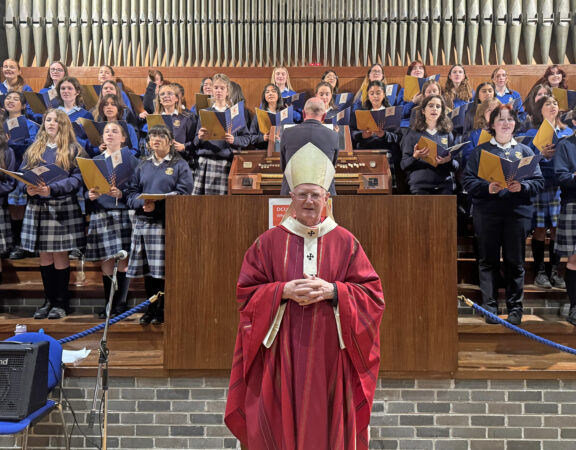Name: Carpenter, John
IDENTITY STATEMENT
Reference Code: IE/DDA/AB1
Title: Papers of Archbishop John Carpenter
Dates: 1770-1786
Level of Description: Fonds
Extent: Two letter books
Digital Archive Collection: Linegar-Carpenter 1751-1779
CONTEXT
John Carpenter was born in Chancery Lane, Dublin, in 1729. He was the son of a merchant tailor but nothing else is known of his family. He attended a school run by Tadgh O Neachtain in South Earl Street. The school had many native Irish speakers and Carpenter soon mastered the language. At the age of 18, John Carpenter went to the Irish College in Lisbon where after the usual course of studies, he was ordained a priest in 1752. When he returned to Ireland in August 1754, he was appointed Curate at St. Mary’s Chapel, Liffey Street.
On 3 June 1770, Dr. Carpenter was consecrated Archbishop of Dublin. There were approximately 15 chapels in the city and three convents in the archdiocese. He chose the parish of St. Nicholas as his mensal parish, while living on Usher’s Island. In his first address at Francis Street, he asked the priests and people for their prayers in helping him with his task in hand. He was an excellent administrator and kept meticulous records and inventories. He also kept copies of letters he received and sent.
Archbishop Carpenter died unexpectedly on 29 October 1786 at the age of 58. He is buried in St. Michan’s, in a grave owned by his brother-in-law, Thomas Lee, husband of Christine Carpenter, and merchant in Pill Lane. The proceeds from the sale of his furniture and effects went to Teresa Mulally to assist financially the school she had establishment in the 1760s.
CONTENT AND STRUCTURE
Archbishop Carpenter lived in an era when the Penal Laws were still enforced. Efforts were being made to end these injustices and in 1760 the Catholic Committee was formed by Dr. John Curry of Dublin, Thomas Wyse of Waterford and Charles O’Connor of Belnagare. Count Taaffe wrote a book entitled ‘Observations of affairs in Ireland’ in 1766. He was an Irishman who had been educated in Germany and had risen to the rank of Field Marshall in the Imperial Army, and was keenly interested in the Irish struggle. He was friendly with Charlotte of Mecklenburg, wife of George III, and decided to go to England to persuade the King to make concessions towards Ireland. He asked the Catholic Committee to provide him with a secretary in London and Fr. John Carpenter or John ‘Mac an tSaor’ was chosen. Unfortunately Taaffe had little success and returned home in 1768. However this did not deter Fr. Carpenter, who throughout his lifetime sought greater freedom for Catholics. He made many attempts to have the Penal Laws relaxed and his efforts saw fruition in 1782, in relation to the law preventing Catholics from buying land. He was also instrumental in having the laws in relation to teaching by Catholics relaxed and ended harassment of the clergy.
In 1763 Carpenter put his name to a petition stating that many parish priests were defrauding their assistants in relation to the chapel-door collections. In his first sermon at St. Nicholas, after being consecrated, he stated that chapel-door collections would be divided equally among all the priests in the parish, showing that his predecessor had not dealt effectively with this on-going problem.

Even though Carpenter was outspoken, his predecessor, Archbishop Patrick Fitzsimon, admitted him to the Metropolitan Chapter. When problems arose at the Irish College in Lisbon, Carpenter was asked to deal with the King of Portugal on behalf of the Irish bishops. The Irish College had been confiscated by the Portuguese government in 1759. A few years later Carpenter met with government officials and laid the basis of its eventual recovery. In 1774 he petitioned for the appointment of Irish rectors to the colleges at Salamanca and Rome. He was highly regarded by Rome and Propaganda frequently asked his opinion of Irish episcopal candidates.
In 1772, Carpenter received a letter from Propaganda College, Rome, asking for a report on the state of education in the diocese as they had not received one in several years. Carpenter replied stating that the law forbade the erection of schools for Catholics but he did furnish some information on those that did exist. Many of the people were uneducated and to help them the Archbishop wrote The Exhortation, an explanation of the Mass, which was to be read each Sunday before Mass began. Many of the people were native speakers and with the help of Charles O’Connor, this was translated into Gaelic and became known as An Teagasc. Priests were ordered to read it before first Mass each Sunday. He also published a set of provincial and synodal constitutions of the archdiocese.
Archbishop Carpenter spoke out about abuses of alcohol, rioters and destroyers of property. He was the first 18th century Archbishop of Dublin to submit a formal report to Rome. The Chapter at that time consisted of six dignitaries and 22 canons. There were 45 parishes, 9 of which were in the city of Dublin. Each of the chapels had between six to eight assistant priests who celebrated daily Mass, heard confessions and preached.
After 1780 his role in political, social and ecclesiastical affairs seems to diminish with much of the work being carried out by the Bishop of Ossory, John Thomas Troy
The surviving papers of Archbishop Carpenter mainly consist to correspondence which are in date order.

Language: English and Latin
Finding Aid: Descriptive Catalogue






